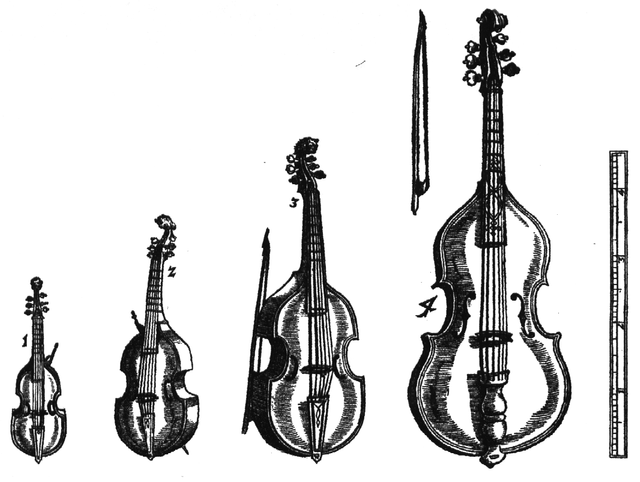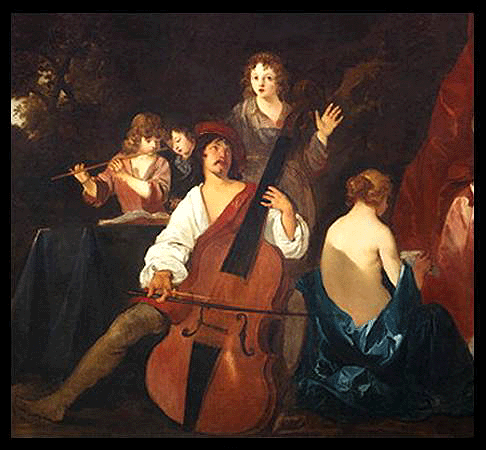The Piccolo Violin: A forgotten instrument

The Piccolo Violin is one of the instruments that hailed from the Baroque (18th century and earlier) era of music that has long fallen into disuse and in modern Classical ensemble/orchestral settings, the Piccolo Violin is to all intents and purposes, extinct. For most modern Classical groups, the Piccolo Violin part is often just covered and transposed for a normal Violin, which detracts from the intended sound world and purpose of the original composer's composition. A regular violin can play the same notes as the Piccolo Violin, but it will sound very different, due to the larger construction and lower tuning of the modern Violin equivalent.
However, the field of Early Music specialists attempt to revive the use of these long lost instruments, in a conscious decision to recreate the sound world and context of the original compositions from the Baroque era. To understand why the Piccolo Violin existed in the first place and to understand the reasons for it's eventual decline in the intervening centuries, one must look further back into the history of the Violin family of instruments.
Before the Violin

Before the dominance of the Violin family of instruments in the String sections of Classical Music, there existed another group of instruments. These were known as the Viols (or Viola da Gambi), of which the only modern survivor is the Double Bass. These Viols continued the tradition at the time of having matched sizes of of instruments (known as consorts) with different physical sizes and tunings that defined the part that they would play in the consort. In the video below, you can see a consort that is made up of (from high to low): 2 treble viols, 2 tenor viols, a lyra and a bass viol.
The idea was that all the instruments would be playing in their best register that was defined by it's physical size (which was defined by the Physics of Acoustics), namely that the smaller the instrument the higher the pitch. Thus, if you wanted a higher pitch, you had a smaller instrument, rather than traversing down the fingerboard of a larger instrument (which produced the same note, but a different quality of sound). Likewise, if you wanted a lower sound, then you had an instrument with a corresponding large body, which allowed for a longer string length, thus producing a more bassier sound.
Consorts of viols were of varied sizes, and compositions for them required differing numbers of voices at different pitches. Thus, there was no standard "set" of viols. However, in his book Musick's Monument (1676), the music theorist Thomas Mace suggests that a "good" size for a chest of viols was:
"six in number, 2 Basses, 2 Tenors, 2 Trebles, all truly proportionally suited"
It was quite common for wealthy families of the time to own various matched sets of instruments (be they matched viols, lutes, recorders or otherwise). A Consort was a grouping of such matched instruments of the same type, whereas a "broken" consort would consist of unmatched instruments such as a viol, a recorder and a lute. It was always considered better to have a matched consort, as this would result in a more harmonious and blended sound, but if you could not afford a matched set, then a "broken" consort would have to suffice. I have included two addition videos, one of a matched wind consort and another of a "broken" consort.
The Violin Family

So, this was the context in which the early Violin family developed at the end of the Renaissance and early Baroque eras. Long before the standardisation of the Violin family into the modern triplet of Violin, Viola and Cello; the consort idea of musical instruments still held sway. Thus, the Violin family consisted of many more members, of which the Piccolo Violin was the highest sounding (and thus the smallest physically) of the family. Other instruments that have fallen away were the tenor Viola/Violin (a viola that is tuned below the modern viola, and is significantly larger, although still held like a Violin), the bass Violin (which was larger than the Cello and tuned lower again) and the Violone (the largest in size of the family). There are existing examples of these instruments, however many of them were lost or "converted" over the intervening centuries as the drive for standardisation continued. For instance, there are many examples of the bass Violins in existence, but the had been irreparibly cut down to a more manageable cello playing size.
The Piccolo Violin

In the image above, you can see the comparison in size of the Piccolo Violin (top) compared to a normal sized Violin (bottom). It is noticeably smaller, in body length as well as string length, which means that it can support a much higher pitch at the same string tension compared to the regular sized Violin. The higher pitch means that it is much better suited to playing soprano lines, which would require position shifting on the regular Violin, which whilst not being difficult, makes for a completely different sound quality.
The tuning of the Violin (from low to high) is B flat - F - C - G, which is a minor third higher than a "normal" Violin, generally if a "normal" Violin was tuned this high, it would result in many broken strings and possibly damage to the body and bridge of the instrument due to the markedly higher string tension (and thus, the force downwards onto the body via the bridge). However, there was not a single standard tuning, and there is evidence that the instrument could go even higher in pitch(a fourth was not uncommon).
The best preserved existing copy from the Baroque/Renaissance era of a Piccolo Violin is an Amati construction, which is currently held at the National Music Museum, in Vermillion, South Dakota (United States). However, we have documentary evidence of the existence of the violin, in addition to specific composer instructions for parts that are written for a Piccolo Violin. For instance the composer/theorist Michael Praetorius, in his Syntagma musicum II: De organographia mentioned the Piccolo Violin in an incredibly offhand way:
“[s]ince they are such familiar instruments I need not say much more about them….”
... and we have compositions that specifically ask for the instrument by name (Piccolo Violino) by composer such as: : Karl Ditters von Dittersdorf, Johann Friedrich Doles, Philip Heinrich Erlebach, Christoph Förster, Johann Joseph Fux, Johann Gottlob Harrer, Johann Gottlieb Janitsch, Krause, Johann Pfeiffer, and Rosetti. This is in addition to the two most famous examples of composition for the instrument by JS Bach (Brandenburg Concerto #1) and Monteverdi (Orfeo).
Brandenburg Concerto #1

By far and away the most famous composition for the Piccolo Violin is the First Brandenburg Concerto by JS Bach. Scored for 3 oboes, 2 horns in F, Piccolo Violin Solo and Strings and Continuo, this is the first concerto from the epic Brandenburg set of concerti. A set of six Concerti that showcase the various instruments from the Baroque era that were composed specifically for Christian Ludwig, Margrave of Brandenburg-Schwedt in 1721. As a measure of how important these concerti were to Bach, he copied these concerti by his own hand, instead of entrusting the work to a copyist.
In a modern setting, the Piccolo Violin is often replaced by a "normal" Violin playing the correct notes. However, this substituting takes much away from the original intend and sound world of the composition.
I hope this has been an informative and somewhat interesting journey into the past history of the Violin family, to bring to light a little known (and mostly unplayed) member of the Violin family, the little baby Piccolo Violin!

The classical music community at #classical-music and Discord. Follow our community accounts @classical-music and @classical-radio. Community Logo by ivan.atman

Join us @steemitbloggers
Animation By @zord189
Upgoats by ryivhnn
Account banner by jimramones

Posted from my blog with SteemPress : http://www.gamerjokerbreadder.com/2018/07/12/the-piccolo-violin-a-forgotten-instrument/




Your post has been supported and upvoted from the Classical Music community on Steemit as it appears to be of interest to our community.
If you enjoy our support of the #classical-music community, please consider a small upvote to help grow the support account!
You can find details about us below.

The classical music community at #classical-music and Discord.
Follow our community accounts @classical-music and @classical-radio.
Follow our curation trail (classical-radio) at SteemAuto or help us out with a delegation!
a very great write up about violin, how i wish i can learn how to play it
Like I mentioned for another commenter, is never too late to try!
Great info as usual !!!
In compare to the full size violin, the piccolo violin looks about an 1/2 or 1/4 size violin....
So I was wondering if it could work tuning a smaller size violin as a piccolo without damaging string or instrument.....
Thank you.
That is a good point, and some musicians do use that compromise solution.
However, it does have a few drawbacks. The first is that the Piccolo is not exactly a half or a quarter size in all its dimensions. The body (the resonance chamber) is larger than the comparable proportions that you would expect from the fingerboard (and string length). So, by having a different proportion of these two measurements, you already have a different quality of sound.
The second part is that most (of not all) of the smaller sized instruments that are made today are of poor quality compared to a professional standard. Thus, you would have to ask a luthier to craft a high quality smaller instrument. And if you were going to do that, you may as well ask for a copy of the real thing!
Edit: I mixed up the relationship, the body is smaller than the neck would suggest.
Yes, you're right, the small size violins are usually basic instruments designed for young beginners.... :-)
This was such an informative and enjoyable post, @bengy
My little emerging violinist will certainly soak all this up and have lots of questions for his instructor this afternoon - I imagine they both will have a hearty conversation about it ;)
I noticed in the first video how the bow is held differently - that is interesting!
Great that you noticed the different bow hold! The viol family (gambas) had more strings than the violin family, and they were also fretted. In addition, they used a underhanded bow grip (which still exists for some double bass players), whilst the violin family (including cellos) developed an overhanded bow grip that allowed for more power. Although, in the early Baroque there were different variants of the overhanded bow grips, and these were not standardised until the French schools of later periods.
So interesting, @bengy Really enjoying your knowledge and wisdom.
How to hold the bow was a biggy for my son - why I noticed. He didn't have range of motion after his surgeries so he had to develop that - so this became the 'center' of his violin playing for quite a while. Important part of playing - holding the bow correctly.
Seems like the underhanded bow would make it more difficult especially when playing sixteenth notes...maybe they didn't?
You would be pretty surprised! The bow is lighter and the mode of sound production uses speed of bow rather than weight of contact! As a result, they are more agile but less powerful!
Listening.....@bengy So beautiful. Love the deeper tones and emotion. Will continue listening to the end. "More agile but less powerful"...yes :)
Thank you so much for taking the time to share this and your knowledge/love of music. I truly, truly appreciate it.
And congratulations on your c-squared support. Much deserved!
Lots of great little bits in here for people who want a detailed survey.
This is interesting to me because I just finished giving a biology lab tutorial on pipetting. We have different micropipettes that can dispense different ranges of liquid. Often, the ranges overlap a little, however, it's best to dispense from the middle of pipette's range. Not quite the same thing, but an neat cousin.
Yes, it is the same idea that comes in and out of all fields. The idea of having many specialised tools or lesser more generalised tools. Both ways are functionally similar, but you trade convenience for (in your case) accuracy.
I really dig it when universal 'laws' arise from disparate things.
Wow, you are a music nerd. (nerd at my house is a good thing)
Quick question though. What would be the main differences in the scaled violins and the Piccolo violin? My oldest daughter plays, and we progressed through 1/8 to full. The tuning is obviously different but is the body thicker/deeper? lol, just curious.
I really enjoyed the post.
Thanks, and nerd is also a badge of honour in my house!
There are two major differences, the first being that the body is a size more suited to the higher pitch, and is this smaller than the fingerboard/neck length would suggest. So it isn't an equally scaled full size.
The second difference is that it has the characteristic (non modern) Baroque construction. For example, a different angling of the fingerboard, a different type (thicker) of bridge and a lighter bass bar.
Makes sense, it would model the sound better that way, and still allow for larger hands to play the instrument easier. I've messed around enough to produce something that resembles music out of a full sized, but her smaller one my fingers are a bit too flat/fat. (plus it's not my instrument I'm used to heavier strings and probably apply too much pressure.)
I am not so musical but I do love knowing the history and details of instrument like you share here
Thanks! The history of music is littered with various instruments and ideas that didn't survive to the present day!
@bengy Ohh yes I surely imagine that is the case
Amazing post @bengy, very informative about something I had no idea until now, 😁 thank you for sharing with us!
Upvotes!
No problem! Glad you found something new to read about!
I have a good collection of instuments, but Violin (or any versions of it) is one instrument I haven't really played, but I'm fascinated with the history of music and found your post very interesting!!
There is a lot in the history of music that has been wilfully forgotten, partly due to musicians being more interested in the intuitive creation of art as opposed to questioning how we arrived at the traditions that bind and define our intuition.
It is strange to think that it is only a recent idea that we should revisit the older music with appropriate context, rather than the modern Classical tradions of the symphonic orchestras!
I was just about to say that this was curie material. 😁
Superbly written.
And some say you can only learn about crypto on Steem.
Thanks! Always good to have feedback from a fellow musician that the piece was decent!
Piece... Yes. I need to do that piece for you. Grrr. Thx for reminding me indirectly. Haha
Haha, completely unintentional!